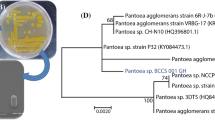Abstract
An enzyme has been isolated fromPseudomonas marginalis (a pathogen responsible for the spoilage of fruits and vegetables in storage) that degrades the exopolysaccharide (mw>2×106 Da) produced by this organism. The mechanism of degradation has been determined to be a depolymerization that results from glucosidic cleavage. The product of depolymerization is a polysaccharide of ca. 2.5×105 Da. The enzyme has a molecular weight of approximately 28 kDa, a pH optimum of 6.5, pI=9.1, and an apparent Km of 1.95×10−7±3.5×10−8 M. Native and enzyme-treated marginalan supported no or very limited growth of the bacterium respectively.
Similar content being viewed by others
Literature Cited
Bacon JSD (1979) Factors limiting the action of polysaccharide degrading enzymes. In: Berkely RCW, Gooday GW, Ellwood DC (eds) Microbial polysaccharides and polysaccharases. New York: Academic Press, pp 269–284
Chan R, Lam JS, Lam K, Costerton K (1984) Influence of cultural conditions on expression of the mucoid mode of growth ofPseudomonas aeruginosa. J Clin Microbiol 19:9–16
Dunn MF, Karr AL (1990) Isolation of an extracellular polysaccharide (EPS) depolymerase produced byBradyrhizobium japonicum. Curr Microbiol 20:359–363
Evans LR, Linker A (1973) Production and characterization of the slime ofPseudomonas aeruginosa. J Bacteriol 116: 915–924
Gooday GW (1979) A survey of polysaccharase production; a search for phylogenetic implications. In: Berkeley RCW, Gooday GW, Ellwood DC (eds) Microbial polysaccharides and polysaccharases. New York: Academic Press, pp 437–460
Guor-Rong H, Glazbrook J, Walker GC, Reinhold VN (1990) Structural studies of a novel exopolysaccharide produced by a mutant ofRhizobium meliloti strain RM 1021. Carbohydr Res 198:305–312
Liao C-H (1989) Analysis of lyases produced by soft rot bacteria associated with spoilage of vegetables. Appl Environ Microbiol 55:1677–1683
Navarini L, Cesaro A, Ross-Murphy SB (1992) Exopolysaccharides fromRhizobium meliloti YE-2 grown under different osmolarity conditions: viscoelastic properties. Carbohydr Res 223:227–234
Nguyen LK, Schiller NL (1989) Identification of a slime exopolysaccharide depolymerase in mucoid strains ofPseudomonas aeruginosa. Curr Microbiol 18:323–329
Osman SF, Fett WF (1989) Structure of the acidic exopolysaccharide ofPseudomonas marginalis HT041B. J Bacterial 171:1760–1762
Osman SF, O'Connor J (1992) A GC/MS method for the determination of the reducing end of oligo- and polysaccharides. J Chromatogr 606:285–287
Osman SF, Fett WF, Hicks KB (1988) Structure of the O-antigen ofPseudomonas syringae pv.phaseolicola strain NPS 3121. Carbohydr Res 176:205–210
Woolley DW, Pringle RB, Braun AC (1952) Isolation of the phytopathogenic toxin ofPseudomonas tabaci, an antagonist of methionine. J Biol Chem 194:409–417
Author information
Authors and Affiliations
Additional information
Mention of brand or firm names does not constitute an endorsement by the U.S. Department of Agriculture over others of a similar nature not mentioned.
Rights and permissions
About this article
Cite this article
Osman, S.F., Fett, W.F., Irwin, P.L. et al. Isolation and characterization of an exopolysaccharide depolymerase fromPseudomonas marginalis HT041B. Current Microbiology 26, 299–304 (1993). https://doi.org/10.1007/BF01575921
Issue Date:
DOI: https://doi.org/10.1007/BF01575921




